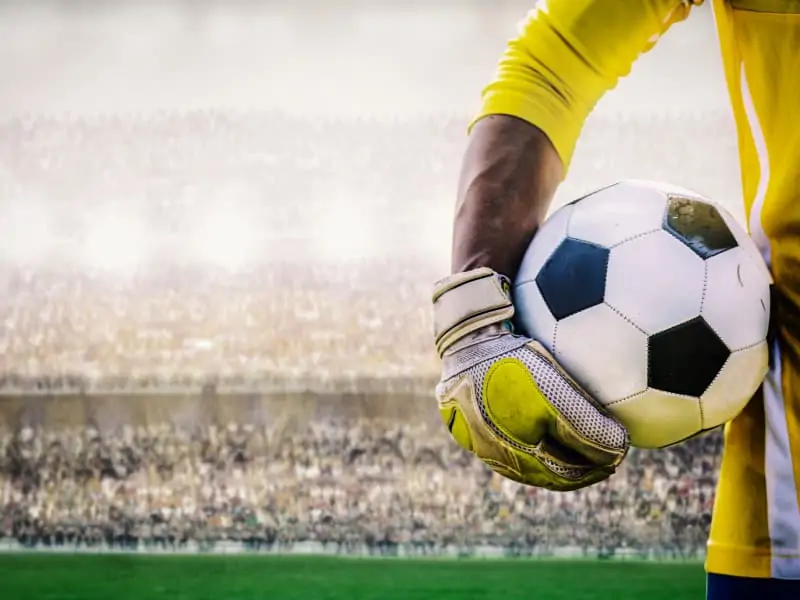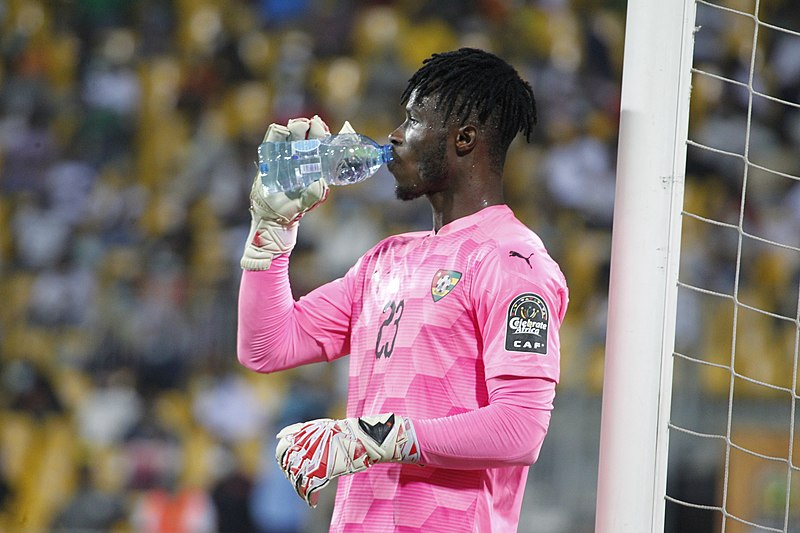Share the post "Soccer Without a Goalkeeper (GK Red Card)"
It is widely agreed upon that a good goalkeeper is worth 10 to 15 league points per season for a team. Inversely, an unreliable ‘keeper can cost a team dearly, particularly in close, important games.
Although we are accustomed to seeing goalkeepers play in all games, have you ever wondered if you can play soccer without a goalkeeper? Can a team intentionally play without a goalkeeper to get a numerical advantage in the outfield positions?
In this article, we investigate the distinctive role of a goalkeeper and learn whether or not a team can play without one.
The key topics we’ll be exploring include:
- The laws of the game surrounding goalkeepers
- Origin of the goalkeeper
- If a goalkeeper can get yellow and red cards
- Outfield players as goalies
- Goalkeeper rules
They say that all goalkeepers are a little crazy! Do you like playing in goal or would prefer soccer without the goalie?

What the Laws of the Game Say
According to the laws of the game, each team must have one designated goalkeeper on the field at all times. It is the only position in the game of soccer that is deemed technically different from any other.
The player designated as goalkeeper abides by a different ruleset than outfield players, most notably regarding handball rules.
To ensure they are easily distinguishable, goalkeepers must wear a different shirt to other players. They are also allowed to wear hats and tracksuit bottoms, while outfield players aren’t.
Check out these Reusch padded goalkeeper pants, giving you extra protection when making diving saves.
Best 3 Goalie Gloves
Product: Updated 2024-07-20 | Images: Amazon Product Advertising API | #ad - soccerblade.com is an Amazon Associate
Have There Always Been Goalkeepers In Soccer?
Goalkeepers were officially introduced in the game of soccer in 1871. They were allowed to handle the ball only to protect their goal. Rules for goalies changed frequently from this point on.
In 1901, they were allowed to handle the ball for any purpose inside their own half of the field. It wasn’t until 1912 that goalies were restricted to only handling the ball inside their penalty box!
While it may enable you to create numerical mismatches in attack, there are no real advantages to playing without a goalkeeper.
Defensively, it would be extremely difficult to prevent the opposition from scoring at will. Even if the rules would allow it, it’s hard to imagine that any team would elect to play without a ‘keeper.

Can a Goalkeeper Get Yellow and Red Cards?
Just like outfield players, goalkeepers can receive yellow and red cards.
While they are statistically less likely to be sent off than defensive midfielders and defenders, goalies pick up their fair share of red cards. What’s more, a red card for a goalkeeper often ends up with a penalty being rewarded to the opposition team.
The main reason for the relatively high number of goalkeeper red cards is their unique position on the field.
Goalkeepers are generally the very last line of defense, meaning any foul they commit is likely to deny a goalscoring opportunity. When goalkeepers intentionally commit a handball outside of their penalty box, it usually results in a red card.
Like with outfield players, goalkeepers who receive two yellow cards also get their marching orders. When a goalie is sent off, the team is left with 10 remaining players.
Although a red-carded goalkeeper can’t be replaced directly, a substitute ‘keeper can be brought on in place of an outfield player as long as the team has enough remaining substitutions.
Because the rules state that each team must have a designated goalkeeper on the field at all times, if a goalkeeper is sent off and there are no replacements available or the team has no remaining substitutes, an outfield player must be designated as the stand-in ‘keeper.
Former Arsenal and German national team goalkeeper, Jens Lehman received a staggering 7 red cards throughout his career.
Most notably, he was sent off for Arsenal against Barcelona in the first half of the 2006 Uefa Champions League final. Barcelona went on to win the game 2-1.
What Happens If a Goalkeeper Gets Injured?
If a goalkeeper gets injured, they can be replaced by a substitute, just like an outfield player would.
There are no special dispensations for injured goalies. If a team doesn’t name a replacement goalkeeper on the bench or they have run out of substitutions, an outfield player will have to assume the goalkeeper role for the remainder of the game.
In the unlikely event that a replacement goalkeeper is injured or sent off, an outfield player will have to take their place, unless the team has another available third-choice ‘keeper on the bench.
Outfield Players as Goalkeepers
As you now know, technically, there must always be a goalkeeper on the field in soccer. However, there have been several high-profile instances where outfield players have had to take their place.
The most famous instances of outfield players playing as goalies include:
- Kyle Walker for Manchester City (2019)
- John O’Shea for Manchester United (2007)
- John Terry for Chelsea (2006)
- Phil Jagielka for Sheffield United (2006)
- Harry Kane for Tottenham Hotspur (2014)
Many sports fans are unaware that Brazilian legend, Pele, stepped in as a goalkeeper on several occasions.
Playing for Santos against Gremio, Pele stepped between the posts when his goalkeeper teammate was forced off the field. He had already scored a hat-trick in the game! Santos managed to hold on for a 4-3 win.
Speaking about Pele, Bobby Moore had to say this:
“I remember Saldanha the coach being asked by a Brazilian journalist who was the best goalkeeper in his squad. He said, Pelé. The man could play in any position.”
Bobby Moore, England World Cup winning captina in 1969
Unique Rules For Goalkeepers
There are several unique rules for goalkeepers that do not apply to outfield players. Let’s take a look at some of the most interesting ones.
Handball
The handball rule is one of the most important in soccer.
It has come under the microscope of late as the widespread use of a video assistant referee (VAR) exposed certain rules’ flaws.
The International Football Association Board (IFAB), which is the organization responsible for governing the laws of the game, is continually tweaking the precise rulings related to handball to ensure they work smoothly and effectively.
When they are outside the confines of their own penalty box, goalkeepers must abide by standard handball rules.
When they are inside their own penalty box, goalkeepers may touch the ball with their hands. Goalies can catch, punch, slap, or deflect the ball with any part of the body to prevent a shot from flying past them into the net.
However, a goalkeeper can’t just handle the ball any time they like. There are specific rules relating to when they can and can’t touch the ball with their hands. Goalkeepers may not handle the ball when:
- The ball is intentionally passed back to them by a teammate.
- The ball is played back to them by a teammate via a throw- in.
- They have already released the ball from their hands. For example, if a goalkeeper catches the ball from a corner kick then drops it on the ground, they cannot touch it with their hands again until an opposition player has made contact with the ball.
Handling the ball in such circumstances generally results in an indirect freekick within the penalty box for the opposing team.

Holding the Ball
After catching the ball, a goalie can hold the ball for 6 seconds before it must be released, kicked, or thrown. Failing to release the ball on time can result in an indirect freekick to the opposition. However, this rule is rarely enforced.
Can a Goalie Be Offside?
While it is very rare, a goalie can be flagged offside. Once they are outside of their own penalty box, a ‘keeper is regarded as a regular outfield player.
Penalty Kicks
The goalkeeper has a unique role in penalty kicks. Other than the kicker, they are the only player allowed inside the box when a penalty is being taken. They are the sole person responsible for trying to save the kick.
There are strict rules for the goalie when it comes to defending penalties.
Although the goalie is permitted to move before the penalty is kicked, they are not allowed to touch the posts, crossbar, or net as the kicker is advancing toward the ball.
Until the ball has left the foot of the kicker, the goalie must have at least one foot touching the goal line.
Share the post "Soccer Without a Goalkeeper (GK Red Card)"
Joel is a seasoned soccer journalist and analyst with many years of experience in the field. Joel specializes in game analysis, player profiles, transfer news, and has a keen eye for the tactical nuances of the game. He played at various levels in the game and coached teams - he is happy to share his insight with you.






